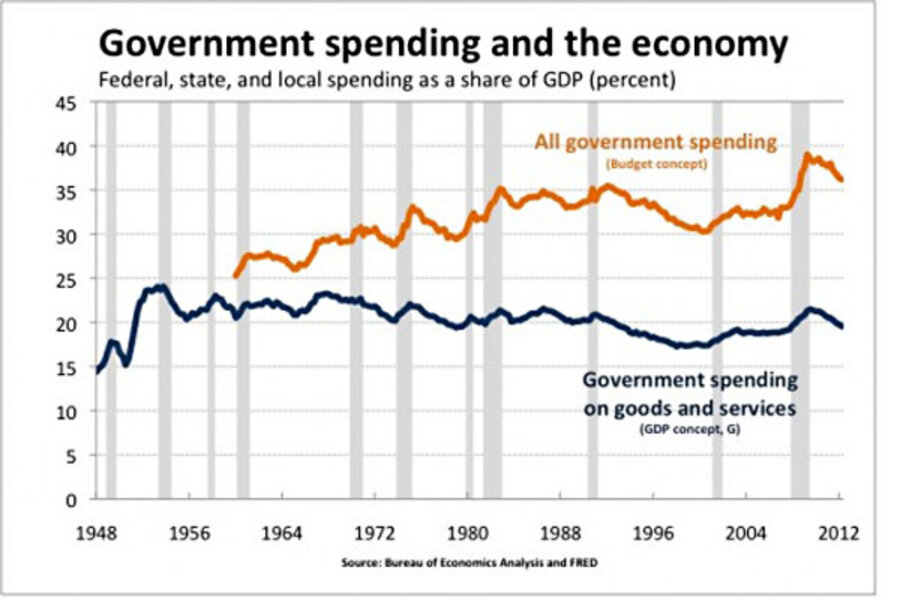Has government gotten bigger or smaller? Both.
Loading...
Politicians and pundits constantly debate the size of government. Is it big or small? Growing or shrinking?
You might hope these simple questions have simple answers. But they don’t. Measuring government size is not as easy as it sounds. For example, official statistics track two different measures of government spending. And those measures tell different stories:
The blue line in the chart above shows how much federal, state, and local governments directly contribute to economic activity, measured as a share of overall gross domestic product (GDP). If you’ve ever taken an intro economics class, you know that contribution as G, shorthand for government spending. G represents all the goods and services that governments provide, valued at the cost of producing them. G thus includes everything from buying aircraft carriers to paying teachers to housing our ambassador in Zambia.
At 19.5 percent of GDP, G is down from the 21.5 percent it hit in the worst days of the Great Recession. As Catherine Rampell of the New York Times pointed out last week, it’s also below the 20.3 percent average of the available data back to 1947. For most of the past 65 years, federal, state, and local governments had a larger direct economic role producing goods and services than they do today.
There’s one notable exception: today’s government consumption and investment spending is notably larger than it was during the economic boom and fiscal restraint of the late 1990s and early 2000s. From mid-1996 to mid-2001, government accounted for less than 18 percent of GDP. Relative to that benchmark, government is now noticeably larger.
The orange line shows a broader measure that captures all the spending in government budgets—all of G plus much more. Governments pay interest on their debts. More important, they make transfer payments through programs like Social Security, Medicare, Medicaid, food stamps, unemployment insurance, and housing vouchers. Transfer spending does not directly contribute to GDP and thus is not part of G. Instead, it provides economic resources to people (and some businesses) that then show up in other GDP components such as consumer spending and private investment.
This broader measure of government spending is much larger than G alone. In 2011, for example, government spending totaled $5.6 trillion, about 37 percent of GDP. But only $3.1 trillion (20 percent of GDP) went for goods and services. The other $2.5 trillion (17 percent) covered transfers and interest.
Like G, this broader measure of government has declined since the (official) end of the Great Recession. Since peaking at 39 percent in the second quarter of 2009, it has fallen to 36 percent in the second quarter of 2012.
Also like G, this measure has grown since the boom of the late 1990s and early 2000s. In the middle of 2000, government spending totaled just 30 percent of GDP, a full 6 percentage points less than today.
The two measures thus agree on recent history: government has shrunk over the past three years as the economy has slowly recovered from the Great Recession and government policy responses have faded. But government spending is still notably larger than at the turn of the century.
The story changes, however, if we look further back in time. Although governments spent more on goods and services in the past, total spending was almost always lower. Since 1960, when data on the broader measure begin, total government spending has averaged about 32 percent. It never reached today’s 36 percent until 2008, when the financial crisis began in earnest.
Much of the recent increase in overall spending is due to the severity of the downturn. But that’s not the only factor. Government’s economic role has changed. As recently as the early 1960s, federal, state, and local governments devoted most of their efforts to providing public goods and services. Now they devote large portions of their budgets to helping people through cash and in-kind transfers—programs like Medicare and Medicaid that were created in 1965 and account for much of the growth in the gap between the orange and blue lines.
Government thus has gotten bigger. But it’s also gotten smaller. It all depends on the time period you consider and the measure you use.
P.S. Keep in mind that this discussion focuses on a relative measure of government size—the ratio of government spending to the overall economy—not an absolute one. Government thus expands if government spending grows faster than the economy and contracts if the reverse is true.
P.P.S. Measuring government size poses other challenges. Eric Toder and I discuss several in our paper “How Big is the Federal Government?” Perhaps most important is that governments now do a great deal of spending through the tax code. Traditional spending numbers thus don’t fully reflect the size or trend in government spending. For more, see this earlier post.






